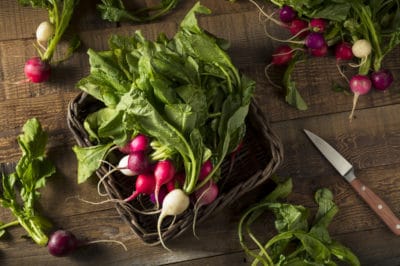Harvesting Conditions
It’s always better to harvest radishes from dry soil. When soil moisture is high it increases the likelihood of rotting after harvest. If the fine root hairs have a chance to dry out a bit, it puts the plant in a semi-dormant state and can increase shelf life by several days.
Keep It Cool
Once they are actually harvested, keeping the roots moist actually increases shelf life. Harvest the plants and set the whole plant, root down, in a shallow bowl or pan with about an inch or two of water in it. You can store at room temperature for several days. In the fridge, these radishes should last five to eight days.
Keep Them Wet
If you have a lot of radishes, wash and trim the root tips off. Remove the radish leaves or greens. Fill a wide-mouthed canning jar with the radishes, then add water until the jar is full. Put on the lid and store in the refrigerator up to eight days.
Bag Them Up
Radishes can be stored in plastic bags in the refrigerator with a damp (not dripping) paper towel at the bottom. Place the bagged radishes in a cool, moist, dark place – the crisper drawer is ideal. Stored this way, radishes may last several weeks.
Down the Cellar
If you have a root cellar, you can store radishes there. You’ll need high humidity – about 90 to 95 percent. Harvest radishes, trim tops and place in layers in boxes or crates filled with sand. Check at least once a week and remove any radishes that show signs of rot. These radishes may last three months.
Choose Your Varieties
Fall and winter radishes typically store better. Some, like the Black Spanish, are bred specifically for storing. Choose these varieties for long-term storage:
- Daikon
- Miyashige
- Misato Rose
- China Rose
- Black Spanish Round
In-Ground Storage
Fall-grown radishes can be stored in the ground in many climates. You should plant about 30 days before your first expected frost. Mulch with about four or five inches of hay, straw or leaves. You could also cover with floating row cover or a mini-greenhouse.
Try a Cold Frame
A cold frame is another option for in-ground storage. These garden structures can act like a small greenhouse, but sit directly on the ground or a growing bed. You could also plant the radishes in containers and keep them in a cold frame through the winter.
